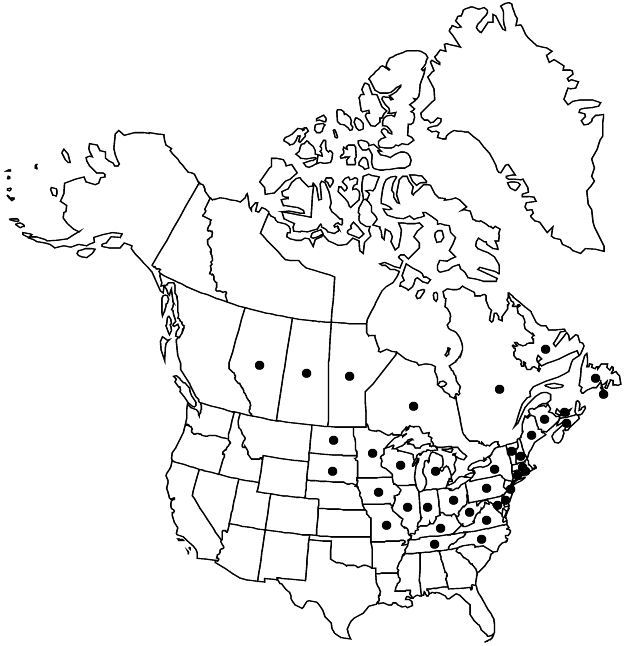Spiraea alba
Harbk. Baumz. 2: 430. 1772.
Shrubs, 10–20 dm. Stems erect, unbranched. Leaves: petiole 2–8 mm, puberulent or sparsely hairy; blade narrowly lanceolate to oblanceolate or broadly oblanceolate to obovate, 2–9 × 0.5–3 cm, length 3–5 times width, chartaceous or membranous, base cuneate to rounded, margins finely to coarsely, sharply serrate to serrulate (sometimes doubly so on long-shoot leaves), number of primary and secondary serrations 0.5–1.1 times number of secondary-veins (excluding inter-secondary veins), venation pinnate craspedodromous, secondary-veins not prominent, irregularly terminating in primary teeth, inter-secondary veins usually 8–12+ per leaf, apex acute to obtuse, abaxial surface mostly glabrous, adaxial glabrous. Inflorescences mostly terminal, narrowly conic to open, pyramidal panicles, 5–20 × 3–10 cm height 1.4–3.5 times diam.; branches usually in axils of leaves, puberulent to pubescent. Pedicels 1–2 (–3) mm, glabrous or glabrate. Flowers 3–8 mm diam.; hypanthia hemispheric, 0.6–0.8 mm, abaxial surface usually puberulent to sparsely strigose, sometimes glabrate or glabrous, adaxial glabrous; sepals triangular, 0.8–1.5 mm; petals usually white, sometimes pink-tinged (in bud), suborbiculate, 1.3–2 (–3) mm; staminodes 0–4; stamens 30–50, 1–2 times petal length. Follicles oblanceoloid, 3–4 mm, shiny, glabrous.
Distribution

Alta., Man., N.B., N.S., Ont., P.E.I., Que., Sask., Conn., Del., Ill., Ind., Iowa, Ky., Maine, Mass., Md., Mich., Minn., Mo., N.C., N.Dak., N.H., N.J., N.Y., Ohio, Pa., R.I., S.Dak., Tenn., Va., Vt., W.Va., Wis., in Europe
Discussion
Varieties 2 (2 in the flora).
Varieties alba and latifolia have regions of hybridization, primarily around the Great Lakes, that produce intermediate forms that may be difficult to key. Recognition of these two taxa as either species or varieties has been problematic because the taxa are quite distinct at the extremes of their range. A. R. Kugel (1958) recognized them as distinct species and her work illustrates the regional zone of hybridization. H. A. Gleason (1952) and Gleason and A. Cronquist (1963) also recognized the two taxa as separate species; later Gleason and Cronquist (1991) recognized them as varieties that frequently intergrade.
The European Spiraea salicifolia has a leaf morphology that is similar to that of var. alba and the two taxa have been treated as conspecific. With the interest in Spiraea as an ornamental, S. salicifolia was imported to North America, resulting in this species or hybrids of it becoming naturalized. Specimens that are difficult to identify may be S. salicifolia, as escapes from homesteads and gardens that became established or may have hybridized with native taxa.
Spiraea alba has become locally naturalized in western and central Europe; in the British Isles, its hybrids are commonly naturalized as S. ×rosalba Dippel (S. alba × S. salicifolia), or as S. ×billardii Hortus ex K. Koch (S. alba × S. douglasii) (A. J. Silverside 1990).
Selected References
None.
Lower Taxa
Key
| 1 | Leaves: lengths 3–4 times widths, margins finely serrate to serrulate; inflorescences narrowly conic. | Spiraea alba var. alba |
| 1 | Leaves: lengths 2–3 times widths, margins coarsely serrate; inflorescences open, pyramidal. | Spiraea alba var. latifolia |